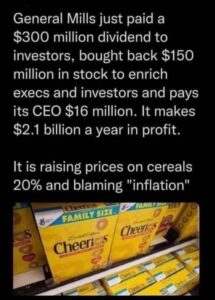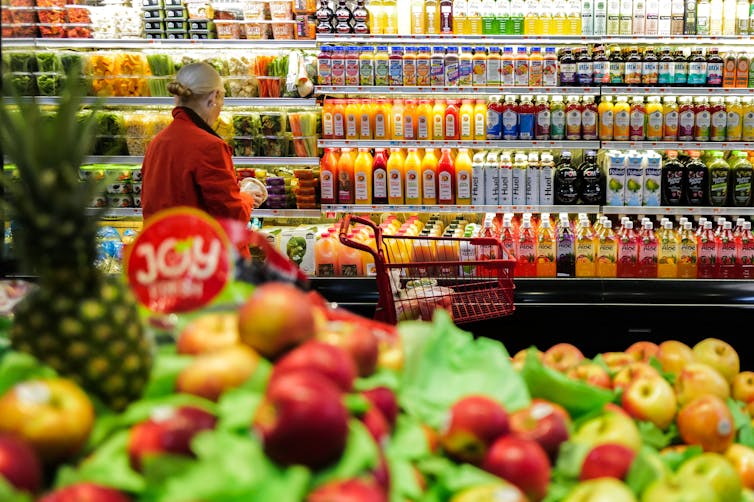
Peter A. Coclanis, University of North Carolina at Chapel Hill
Though cynics may question her motives, Kamala Harris’s recent call to ban price gouging on groceries has received a lot of attention—and for good reason.
The cost of food has been a big concern for Americans since the height of the COVID-19 pandemic, with U.S. food prices rising 25% between 2019 and 2023. While U.S. food inflation slowed considerably in 2024, grocery prices remain up from prepandemic numbers.
Price hikes like this are as painful as they are aggravating and can have real effects on household spending and the broader economy. So, it’s unsurprising that the topic is coming up on the campaign trail.
But often, complexity can get lost amid the politicking. Here, economic history—and economic historians like me—can provide some context.
How Americans spend their food dollars
For starters, despite the run-up in food prices in the U.S., there’s little evidence of price gouging in the grocery industry today.
“Price gouging” is notoriously difficult to define. Still, the term is usually invoked after a supply or demand shock, when sellers are said to take advantage and jack up prices, particularly for basics such as food or gasoline. Concern over “gouging” goes way back – in some ways, it can be seen as an outgrowth of medieval Christian injunctions against mercantile greed.
Although many states have laws against price gouging, such laws have proved difficult to enforce. In the case of the U.S. grocery industry, profit margins—traditionally razor-thin at about 1% or 2%—remain small even today.

Moreover, it’s important to note that food prices in the U.S. are relatively the cheapest worldwide and have been for a long time. This is the case whether measured in terms of disposable personal income or percentage of household expenditures.
For example, U.S. Department of Agriculture data shows that in 2023 — the most recent year for which data are available — Americans spent about 11.2% of their disposable personal income – or income after taxes – on food. That was unchanged from 2022.
This includes expenditures for both food at home — generally purchased at supermarkets and other grocery stores — and food purchased “away” at restaurants and the like. Interestingly, the “away” component has been growing as a proportion of total food spending since the onset of COVID-19.
Grocery prices around the world
No one likes to pay more for food, but a little comparative data can reduce one’s sense of victimization, if not alleviate the pocketbook pain.
Cross-national data compiled by the USDA shows that in 2022, Americans spent less on food as a proportion of total consumer expenditures than people in any other country. People in many other nations spent two, three, or four times as much in percentage terms, and sometimes even more.
The differences were greatest between the U.S. and low-income countries in South Asia and Africa – Bangladesh, Myanmar, and Ethiopia, for example – but were also quite sizable between the U.S. and middle-income countries such as Argentina, Brazil, China, Costa Rica, and Mexico.
These differences aren’t altogether surprising. Why not? As the German statistician Ernst Engel first noted in the middle of the 19th century, the proportion of the total spent on food declines as family or household income increases. After all, you can only eat so much, no matter how rich you are.
Scholars have found that Engel’s insight still applies in the contemporary world, which provides context for the sharp distinctions between low-income and middle-income countries and the U.S.
That said, however, there are big differences between the U.S. and other high-income countries such as Japan, Sweden, Norway, France, and Italy. The U.S. percentage spent on food is considerably lower than in any of these other rich countries. This is because economies of scale are more important in American agriculture, among other reasons.
If so inclined, one can point to certain negative environmental externalities in American food production and question how animals and laborers are treated in the American food system, which prizes efficiency — or at least low prices — above all else.
But food that is dirt cheap in comparative terms, even in a time of rising food prices, is a problem virtually every other nation in the world would love to have.![]()
Peter A. Coclanis, Professor of History; Director of the Global Research Institute, University of North Carolina at Chapel Hill
This article is republished from The Conversation under a Creative Commons license. Read the original article.





1 Comment
Pingback: Our children and grandchildren must wonder what we were thinking of. And with. - Bergensia